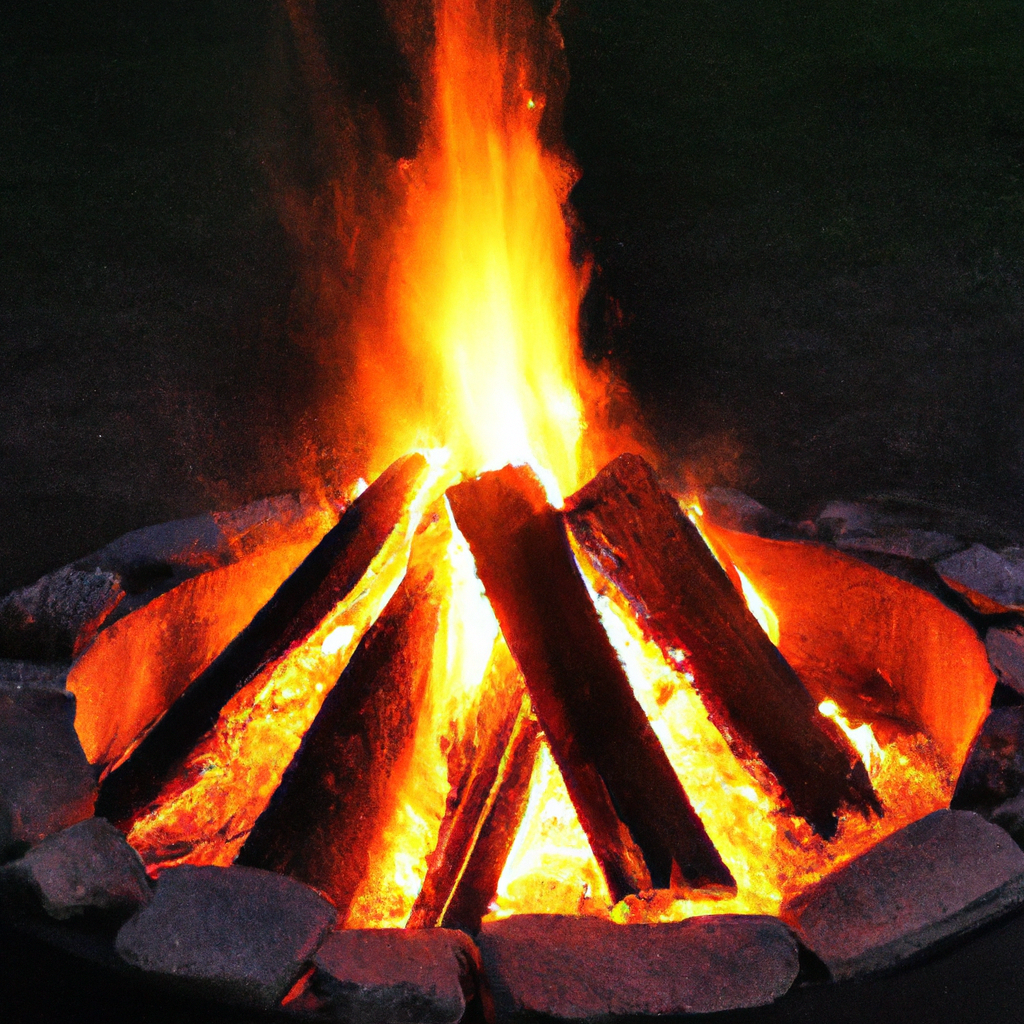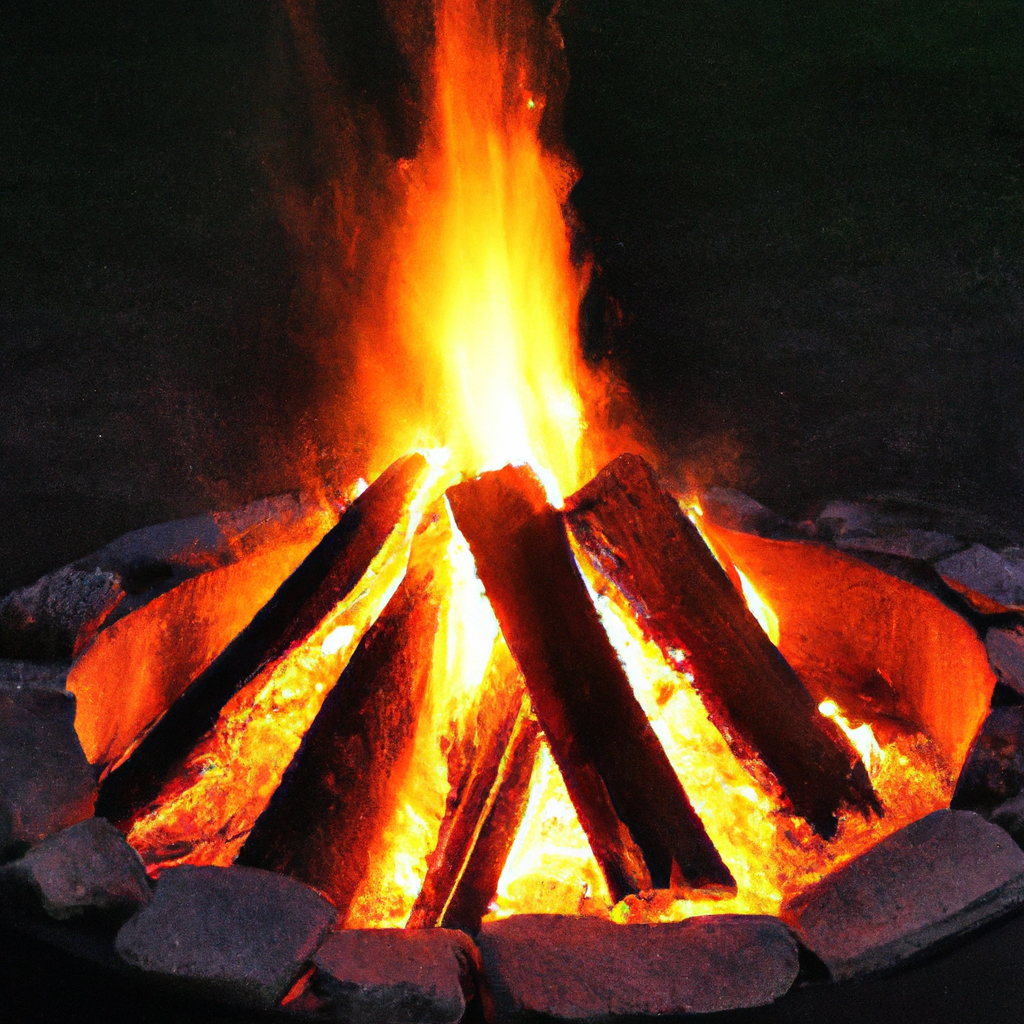Imagine yourself surrounded by nature, the crackling sound of the fire and the warm glow illuminating the faces of your friends and family. Setting up a campfire ring or designated fire area is essential for a safe and enjoyable camping experience. But with so many options and techniques out there, how do you ensure you’re creating the perfect setup? In this article, we will explore the best practices and tips for setting up a campfire ring or designated fire area, ensuring that your camping adventures are filled with unforgettable moments and cherished memories.

Choosing a Location
Consider the Surroundings
When choosing a location for your campfire ring or designated fire area, it’s important to consider the surroundings. Look for an area that is away from any flammable objects such as buildings or dry vegetation. It’s also a good idea to choose a location that offers some shelter from wind, as this will help prevent the fire from spreading and keep it under control.
Check Local Regulations
Before you start setting up your campfire ring, make sure to check the local regulations regarding fires. Some areas may have restrictions or bans on open fires, especially during dry seasons or high fire risk periods. It’s important to follow these regulations to ensure the safety of yourself and others.
Find a Level Area
A level area is essential for setting up a campfire ring. This will help prevent the fire from spreading and keep it contained within the designated area. Avoid areas with steep slopes or uneven ground, as these can pose safety hazards and make it difficult to build a stable fire ring.
Stay Clear of Overhanging Branches
When selecting a location, make sure to stay clear of overhanging branches. These branches can catch fire easily and spread the flames to nearby trees or structures. It’s important to have a clearance of at least 10 feet above the fire to ensure safety and minimize the risk of accidental fires.
Preparing the Ground
Clear Vegetation
Before setting up the campfire ring, it’s important to clear away any vegetation from the area. Remove dry leaves, grass, and other flammable debris that may be present. This will help prevent the fire from spreading beyond the designated area and reduce the risk of accidental wildfires.
Remove Flammable Debris
In addition to vegetation, it’s important to remove any other flammable debris from the ground. This includes things like twigs, branches, and fallen leaves. Clearing the area of these materials will help ensure a safer fire experience and minimize the risk of embers or sparks igniting nearby objects.
Dig a Shallow Pit
To contain the fire and protect the surrounding area, it’s a good idea to dig a shallow pit in the ground. The pit should be approximately one foot deep and wide enough to accommodate the fire. This will help keep the fire contained and make it easier to maintain and control.
Create a Circle
Once the pit is dug, create a circle around it using rocks or other non-flammable materials. This will serve as a visual boundary for the fire and help prevent its spread. The circle should be at least three feet in diameter to provide enough space for the fire and to ensure safety.
Selecting Fire-resistant Materials
Stone or Metal Fire Ring
One option for building a fire ring is to use stone or metal materials. These are highly fire-resistant and can withstand the intense heat of a campfire. Stone or metal fire rings are durable, long-lasting, and provide a sturdy base for the fire.
Fire Bricks
Another option is to use fire bricks to construct the fire ring. Fire bricks are specially designed to withstand high temperatures and are often used in the construction of fireplaces and kilns. They are easy to stack and can be arranged in a circular shape to create a fire ring.
Concrete Pavers
Concrete pavers are another fire-resistant material that can be used for building a fire ring. They are readily available, durable, and can withstand the heat of a campfire. Concrete pavers can be arranged in a circular pattern to create a fire ring that is both functional and aesthetically pleasing.
Heavy-gauge Metal
If you prefer a more flexible option, you can also use heavy-gauge metal to construct a fire ring. Metal rings are portable and can be easily moved or adjusted to accommodate different fire sizes. However, it’s important to choose a heavy-gauge metal that can withstand the heat of the fire without warping or melting.

Building the Fire Ring
Place the Base Layer
To start building the fire ring, begin by placing the base layer of your chosen fire-resistant material. Whether you’re using stone, fire bricks, concrete pavers, or metal, arrange them in a circular shape around the shallow pit. Ensure that the materials are tightly packed together to create a stable base for the fire.
Add Additional Layers
After the base layer is in place, continue adding additional layers of the fire-resistant material. This will help increase the height and stability of the fire ring. Depending on the desired height, you can add as many layers as needed, ensuring that each layer is securely stacked on top of the previous one.
Ensure Stability
As you build the fire ring, it’s important to ensure its stability. Make sure that each layer of the fire-resistant material is tightly packed and securely stacked. This will prevent the fire ring from collapsing or shifting during use, which could be dangerous and increase the risk of the fire spreading.
Consider Airflow
When building the fire ring, it’s important to consider airflow. Adequate airflow is essential for a healthy fire, as it helps with combustion and maintains a steady burn. Avoid completely enclosing the fire ring, as this could restrict airflow and cause the fire to smolder. Instead, leave gaps or openings in the ring to allow for proper ventilation.
Providing Adequate Seating
Using Logs or Benches
One popular option for seating around a campfire ring is using logs or benches. Logs provide a rustic and natural seating option, while benches can be more comfortable and adjustable. Arrange the logs or benches in a semi-circle shape around the fire ring to create a cozy seating area for everyone to enjoy.
Utilizing Stone or Concrete Blocks
Another option for seating is utilizing stone or concrete blocks. These materials are fire-resistant and can withstand the heat of the fire. Arrange the blocks in a circular or semi-circular pattern around the fire ring to create a stable and durable seating area.
Portable Camp Chairs
For a more flexible seating option, consider using portable camp chairs. These chairs are lightweight, foldable, and easy to transport. They provide comfortable seating and can be easily adjusted to accommodate different seating preferences. Just make sure to place the chairs a safe distance away from the fire to prevent any accidents or injuries.
Considerations for Accessibility
When providing seating, it’s important to consider accessibility. Ensure that the seating area is easily accessible for everyone, including individuals with mobility limitations. Provide ramps or clear paths to the seating area and ensure that there is enough space for wheelchair users to maneuver comfortably.
Arranging Firewood Storage
Create a Stacking System
To keep your firewood organized and easily accessible, create a stacking system. Stack the firewood in a neat, vertical manner to maximize storage space and allow for good airflow. This will help the firewood dry out and be ready for use when needed.
Designate a Woodpile Area
It’s important to designate a specific area for your firewood pile. This will help keep the firewood separate from the rest of the campsite and prevent it from being scattered or misplaced. Choose a location that is close to the fire ring for easy access during bonfires.
Keep Wood Elevated
To protect the firewood from moisture and pests, it’s important to keep it elevated off the ground. Use pallets, wooden platforms, or other materials to create a raised platform for the firewood. This will help prevent water absorption and discourage pests from nesting in the woodpile.
Protect Wood from Moisture
Firewood that is wet or damp can be difficult to burn and may produce excessive smoke. To protect your firewood from moisture, cover the woodpile with a tarp or waterproof cover. This will help keep the firewood dry, ensuring a more enjoyable and efficient campfire experience.
Establishing Safety Measures
Maintain a Safe Distance
When enjoying a campfire, it’s crucial to maintain a safe distance from the flames. Keep chairs, logs, and other seating options at least three feet away from the fire ring to prevent accidental burns or injuries. Remember that embers can jump, so always err on the side of caution and give the fire a wide berth.
Keep a Fire Extinguisher
Having a fire extinguisher nearby is an essential safety measure when setting up a campfire ring. In case of emergencies or if the fire gets out of control, a fire extinguisher can quickly suppress the flames and prevent further damage. Make sure to familiarize yourself with proper fire extinguisher usage and keep it easily accessible at all times.
Have a Water Source Nearby
In addition to a fire extinguisher, it’s important to have a water source nearby. This can be a bucket of water, a hose, or a nearby water source such as a lake or river. Water can be used to extinguish the fire, control any sparks, or cool down hot coals before leaving the campfire unattended.
Educate Campers on Fire Safety
Before enjoying a campfire, it’s vital to educate all campers on fire safety. Teach them how to safely start, maintain, and extinguish a fire. Emphasize the importance of never leaving a fire unattended and the necessary precautions to prevent accidental fires. By educating everyone on fire safety, you can ensure a safe and enjoyable camping experience for all.
Respecting the Environment
Collect and Use Deadwood
When gathering firewood, it’s important to respect the environment and leave no trace. Instead of cutting live vegetation, collect and use deadwood that is already on the ground. This ensures that you’re not damaging living plants and helps maintain the natural balance of the ecosystem.
Avoid Cutting Live Vegetation
Cutting live vegetation, such as branches or trees, can have a significant impact on the environment. Avoid cutting live vegetation for firewood and instead focus on gathering deadwood. Cutting live vegetation disrupts habitats, damages ecosystems, and can lead to long-term environmental consequences.
Leave No Trace Principles
To minimize your impact on the environment, it’s essential to follow the Leave No Trace principles. Pack out all trash and dispose of it properly, including any food scraps or packaging. Leave the area as you found it, ensuring that there are no signs of your presence except for the designated fire ring.
Properly Extinguish and Clean Up
After enjoying a campfire, it’s crucial to properly extinguish and clean up the fire ring. Pour water over the fire and stir the ashes until they are cool to the touch. Once the fire is completely out, dispose of the ashes in a designated ash pit or bag and pack them out. Leave the fire ring clean and ready for the next campers to enjoy.
Considering Local Wildlife
Keep Food Contained
To avoid attracting wildlife to your campsite, it’s important to keep your food contained. Store food in sealed containers or coolers and avoid leaving it out in the open. This will help prevent animals from being tempted by the smell of food and reduce the risk of human-wildlife conflicts.
Dispose of Food Scraps Properly
When disposing of food scraps, make sure to do so properly. Avoid throwing them directly into the fire, as this can create excessive smoke and attract animals. Instead, collect the food scraps in a sealed bag or container and pack them out with your other trash.
Avoid Burning Food Waste
Burning food waste is not recommended, as it can attract wildlife and disrupt the natural ecosystem. Instead, opt for proper disposal methods such as packing out the waste or using designated trash bins. This will help minimize your impact on the environment and maintain the balance of local wildlife habitats.
Respect Animal Habitats
While enjoying a campfire, it’s important to respect the habitats of local wildlife. Avoid disrupting their natural habitats by refraining from collecting materials such as rocks or branches from their environment. Appreciate the wildlife from a distance and avoid any actions that could disturb or harm them.
Maintaining the Fire Ring
Regular Inspections
To ensure the safety and longevity of your fire ring, it’s important to conduct regular inspections. Check for any signs of damage or wear, such as loose stones or rusting metal. Regular inspections will allow you to identify any issues early on and take appropriate measures to repair or replace damaged components.
Repair or Replace Damaged Components
If you notice any damaged components during your inspections, it’s important to take prompt action. Repair or replace any loose stones, cracked bricks, or damaged metal parts to maintain the integrity of the fire ring. This will help prevent accidents, maintain safety, and prolong the lifespan of your fire ring.
Keep the Area Clean
Maintaining a clean area around the fire ring is essential for both safety and aesthetics. Regularly remove any debris or ashes from previous fires to prevent them from interfering with the airflow or creating a messy environment. A clean fire ring area will enhance the overall camping experience and make it more enjoyable for everyone.
Monitor Fire Restrictions
Fire restrictions can change depending on weather conditions, local regulations, or seasonal factors. It’s crucial to stay informed about any fire restrictions in your area and adjust your fire ring usage accordingly. Monitor announcements, check with local authorities, or consult park staff for the most up-to-date information on fire restrictions.
By following these guidelines and taking the necessary precautions, you can set up a safe and enjoyable campfire ring or designated fire area. Remember to always prioritize safety, respect the environment, and adhere to local regulations. With the right location, proper materials, and thoughtful considerations, your campfire experience will be memorable and worry-free.

